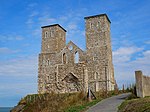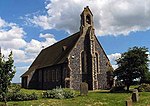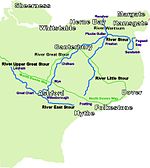St Mary's Church, Reculver, was founded in the 7th century as either a minster or a monastery on the site of a Roman fort at Reculver, which was then at the north-eastern extremity of Kent in south-eastern England. In 669, the site of the fort was given for this purpose by King Ecgberht of Kent to a priest named Bassa, beginning a connection with Kentish kings that led to King Eadberht II of Kent being buried there in the 760s, and the church becoming very wealthy by the beginning of the 9th century. From the early 9th century to the 11th the church was treated as essentially a piece of property, with control passing between kings of Mercia, Wessex and England and the archbishops of Canterbury. Viking attacks may have extinguished the church's religious community in the 9th century, although an early 11th-century record indicates that the church was then in the hands of a dean accompanied by monks. By the time of Domesday Book, completed in 1086, St Mary's was serving as a parish church.
The original building, which incorporated stone and tiles scavenged from the Roman fort, was a simple one consisting only of a nave and an apsidal chancel, with a small room, or porticus, built out from each of the church's northern and southern sides where the nave and chancel met. The church was much altered and expanded during the Middle Ages, including the addition of twin towers in the 12th century; the last addition, in the 15th century, was of north and south porches leading into the nave. This expansion coincided with a long period of prosperity for the settlement of Reculver: the settlement's decline led to the church's decay and, following unsuccessful attempts to prevent the erosion of the adjacent coastline, the building was almost completely demolished in 1809.
The church's remains were preserved by the intervention of Trinity House in 1810, since the towers had long been important as a landmark for shipping: preservation was achieved through the first effective effort to protect the cliff on which the church then stood from further erosion. Some materials from the structure were incorporated into a replacement church, also dedicated to St Mary, built at Hillborough in the same parish. Much of the rest was used for the building of a new harbour wall at Margate, known as Margate Pier. Other, surviving remnants include fragments of a high cross of stone that once stood inside the church, and two stone columns from a triple arch between the nave and chancel: the columns formed part of the original church and were still in place when demolition began. The cross fragments and columns are now kept in Canterbury Cathedral, and are among features that have led to the church being described as an exemplar of Anglo-Saxon church architecture and sculpture.








